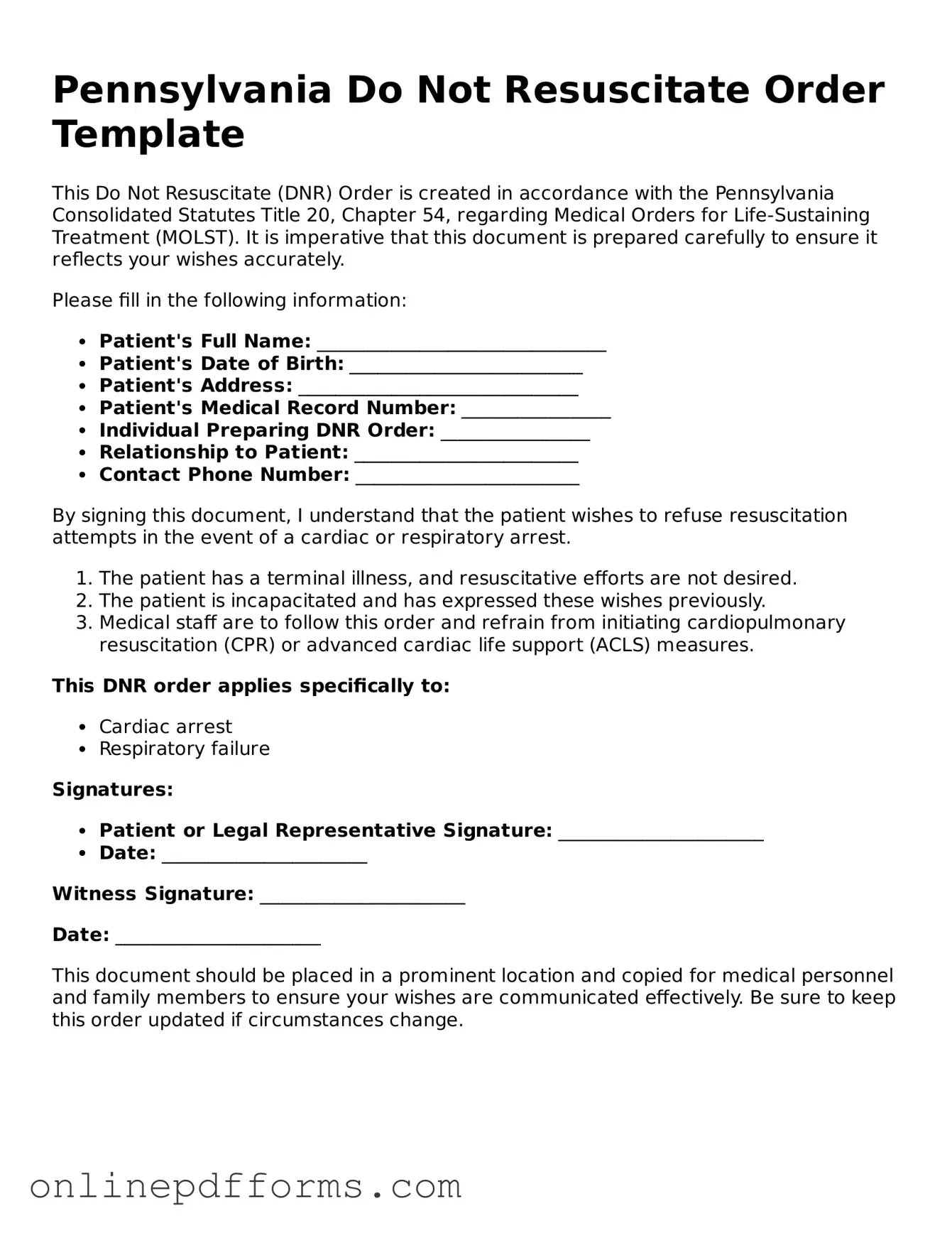The Pennsylvania Do Not Resuscitate (DNR) Order form is similar to a Living Will. A Living Will allows individuals to outline their preferences for medical treatment in situations where they cannot communicate their wishes. Both documents aim to respect the patient’s autonomy regarding end-of-life care. While the DNR specifically addresses resuscitation efforts, a Living Will can cover a broader range of medical interventions, providing guidance on various treatments the individual may or may not want in critical situations.
Another document that shares similarities with the DNR Order is the Medical Power of Attorney. This legal document designates a person, known as an agent, to make healthcare decisions on behalf of an individual if they become incapacitated. Like the DNR, the Medical Power of Attorney emphasizes the importance of honoring a person’s healthcare preferences. However, it allows for a broader scope of decision-making, whereas the DNR focuses specifically on resuscitation efforts.
The Physician Orders for Life-Sustaining Treatment (POLST) form is also comparable to the DNR Order. POLST is designed for individuals with serious health conditions and provides specific medical orders regarding treatments, including resuscitation. Similar to the DNR, the POLST form must be signed by a physician and is intended to ensure that a patient’s wishes are followed in emergency situations. Both documents are critical in communicating a patient’s desires to healthcare providers.
The Advance Healthcare Directive is another document that aligns with the DNR Order. This directive combines elements of a Living Will and Medical Power of Attorney, allowing individuals to specify their healthcare preferences and appoint an agent. Both documents prioritize patient autonomy and ensure that healthcare providers understand the individual’s wishes, especially in scenarios where they cannot express themselves.
The Order for Life-Sustaining Treatment (OLST) is similar to the DNR in that it provides specific instructions regarding resuscitation and other life-sustaining measures. This order is often used in conjunction with a DNR and allows for a more comprehensive approach to end-of-life care. Both documents serve to ensure that healthcare providers respect the patient’s wishes during critical medical situations.
The Comfort Care Order also shares similarities with the DNR Order. This document focuses on providing comfort and alleviating pain rather than prolonging life through aggressive medical interventions. Like the DNR, the Comfort Care Order emphasizes the importance of patient preferences in end-of-life care, ensuring that comfort and quality of life are prioritized over invasive treatments.
The Health Care Proxy is another document that resembles the DNR Order. This document appoints someone to make healthcare decisions on behalf of an individual if they are unable to do so. While the DNR specifically addresses resuscitation, the Health Care Proxy allows for broader healthcare decisions, ensuring that the appointed individual can advocate for the patient’s wishes in various medical situations.
The End-of-Life Care Plan is also akin to the DNR Order. This plan outlines an individual’s wishes regarding their care as they approach the end of life. Similar to the DNR, it emphasizes the importance of patient preferences and can include various aspects of care, including pain management and resuscitation efforts. Both documents aim to guide healthcare providers in delivering care that aligns with the patient’s desires.
When considering property ownership in Texas, it's important to be aware of various legal documents such as the Texas Quitclaim Deed. This document facilitates the transfer of property between parties without warranties regarding the title's quality, making it particularly useful for property transfers among family members or friends. To smoothly navigate the intricacies of property transfer and avoid any ambiguities, it's essential to understand how to properly complete this form; resources like pdftemplates.info/texas-quitclaim-deed-form can be invaluable in guiding you through the process.
Lastly, the Palliative Care Plan shares similarities with the DNR Order. This plan focuses on providing relief from the symptoms and stress of serious illness. While the DNR specifically addresses resuscitation, the Palliative Care Plan aims to enhance the quality of life for patients, ensuring that their comfort and preferences are prioritized. Both documents work towards creating a patient-centered approach to healthcare, particularly in critical situations.
